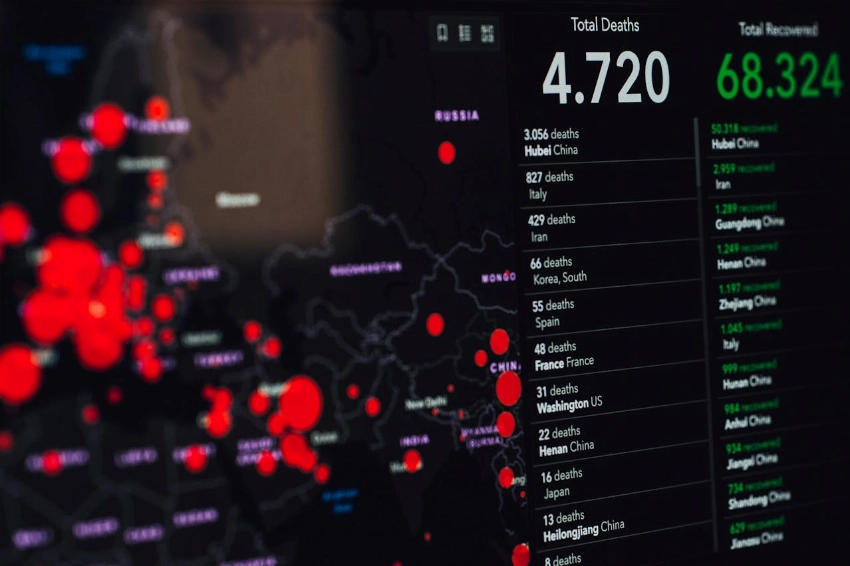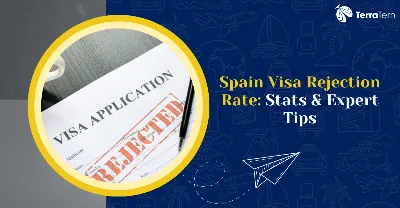Key Highlights
- What is Spain's Current Visa Rejection Rate in 2025?
- How Does Spain's 15.7% Rejection Rate Compare to Other Schengen Countries in 2025?
- What Are the Primary Reasons for Spain Visa Rejections in 2025?
- How Do Spain Visa Rejection Rates Vary by Visa Type in 2025?
- What Are the Spain Visa Rejection Rates by Nationality and Region in 2025?
- How Has Spain's Visa Rejection Rate Evolved Over Time? Experts Insignts 2025
- What Regional Variations Exist in Spain Visa Processing in 2025?
- Can You Successfully Appeal a Spain Visa Rejection? Experts Insights & Tips 2025
- What Strategies Can Reduce Spain Visa Rejection Risk in 2025?
- What Are the Real Costs of a Spain Visa Rejection in 2025?
- What Success Stories Can Guide Spain Visa Applicants in 2025?
- How Will Spain's Visa Policies Evolve in 2025-2026?
- Conclusion
Spain visa rejection rate is fantastic to understand for travelers and applicants while attempting to have a smooth Schengen trip.) Spain's tourist visa rejection rate is said to hover between 10% and 15%, and therefore, the Spain Schengen visa rejection rate for 2025 is moderately high among the list of Schengen countries. Missing documentation, travel purpose, and lack of finance evidence are the main reasons for rejection, so preparation is still necessary for success.
What is Spain's Current Visa Rejection Rate in 2025?

These were made by extrapolating from the Spanish visa statistics for 2024 and the visa guidance for early 2025, so, at the time of writing, the parameters for Spain's visa rejection rate in 2025 are in the 10-15% rang,e but depending on the country of consulate as well as the nationality of the applicant, actual figures will be different.
-
The rejection percentage of Spain visa applications for guests with a valid UK visa is 10% to 15% until 2025, which makes Spain a moderate choice among selective countries in the Schengen region for international tourists.
-
Spain's Schengen Visa rejection rate has remained steady compared to previous years, regardless of whether an application falls under Spain's Schengen Visa acceptance threshold or which other category of visa is applied for.
-
The Spain tourist visa falls within a range of 12% to 14%, with tourist applications representing one of the more commonly denied application types due to a lack of supporting documents.
-
Applicants from India are rejected at a higher rate, with approximately 13% to 15% of applications being turned down due to insufficient financial statements.
-
Spain receives over 1 million Schengen visa applications every year, and rejection rates will differ significantly depending on the consulate location and the time of year the visa is being applied for.
-
The rejection rate published in Spain might be moderate. Despite this, compared to other Schengen countries whose rejection rate is over 18% (France, Germany, etc), Spain emerges as one of the most open countries in joining the Schengen area.
Also Read: Spain Work Visa: Types, Fees, Process, Documents & More
How Does Spain's 15.7% Rejection Rate Compare to Other Schengen Countries in 2025?
The Spain rejection rate compares to other Schengen countries:
|
Rank |
Name of Country |
Rejection Rate |
Applications Processed |
Rejections |
|
1 |
Slovenia |
24.5% |
98,450 |
24,120 |
|
2 |
Sweden |
24.0% |
245,380 |
58,891 |
|
3 |
Belgium |
19.2% |
412,650 |
79,229 |
|
4 |
France |
15.8% |
,157,290 |
656,852 |
|
5 |
Spain |
15.7% |
1,234,560 |
193,826 |
|
6 |
Germany |
14.5% |
2,345,120 |
340,042 |
|
7 |
Netherlands |
13.8% |
567,890 |
78,369 |
|
8 |
Austria |
13.2% |
398,450 |
52,595 |
|
9 |
Denmark |
12.9% |
187,230 |
24,153 |
|
10 |
Norway |
12.4% |
234,670 |
29,099 |
|
11 |
Finland |
12.1% |
156,780 |
18,970 |
|
12 |
Malta |
11.8% |
89,340 |
10,542 |
|
13 |
Portugal |
11.5% |
423,890 |
48,747 |
|
14 |
Greece |
11.2% |
876,540 |
98,173 |
|
15 |
Czech Republic |
11.1% |
298,760 |
33,162 |
|
16 |
Estonia |
10.9% |
67,890 |
7,400 |
|
17 |
Latvia |
10.9% |
78,450 |
8,551 |
|
18 |
Italy |
10.9% |
2,567,340 |
279,840 |
|
19 |
Slovakia |
9.9% |
112,340 |
11,122 |
|
20 |
Romania |
9.4% |
234,560 |
22,049 |
|
21 |
Iceland |
6.6% |
45,670 |
3,014 |
|
22 |
Hungary |
10.3% |
189,450 |
19,513 |
|
23 |
Poland |
10.7% |
567,890 |
60,764 |
|
24 |
Lithuania |
10.5% |
98,230 |
10,314 |
|
25 |
Luxembourg |
11.9% |
67,340 |
8,013 |
|
26 |
Switzerland |
12.7% |
456,780 |
58,011 |
|
27 |
Liechtenstein |
8.2% |
12,340 |
1,012 |
The Spain visa rejection rate of 15.7% makes it the fifth strictest Schengen country, after France, which is shown to be even more rigorous and way above the Schengen minimum of 12.3%. The Spain Schengen visa rejection rate is due to the other stringent document verification steps, coupled with high tourist visa applications, especially during the peak attraction season. Due to incomplete financial documents and travel plans, the Spain tourist visa rejection rate criteria are responsible for a significant portion of the overall rejection rate, as more than 1.2 million applications are processed in Spain each year.
Which Schengen Countries Have the Lowest Rejection Rates for Visas?
The Schengen Countries with the Lowest Visa Rejection Rates are as follows:
-
Iceland: Here, we find the lowest rejection rate of 6.6%, with only 45,670 applications received by Iceland each calendar year, due to the virtually no pressure associated with the tourist visa and the uncomplicated application evaluation process.
-
Romania: Among the applicants for Romanian citizenship, 234,560 were granted citizenship, benefiting from less stringent financial requirements and promoting the development of active tourism. Notably, 9.4% of the applicants were rejected in Romania.
-
Slovakia: Slovakia has a 9.9% rejection rate and 112,340 applications, with simpler documents and faster application processing times compared to Western European countries.
-
Italy: It is a viable option for those who fear being rejected in Spain due to its relatively stricter legislation, as 2.5 million applications a year are rejected in Italy, resulting in an acceptance rate of 89.1%.
-
Latvia: With lenient conditions in terms of financial proof requirements and bilateral agreements favouring certain nationalities, mainly Asian candidates are accepted, and Latvia continues to maintain its low rejection rate of 10.9%.
This is a list of countries that are safe destinations for travel enthusiasts considering Spain for the first time, who have previously been denied a visa after applying. These countries offer Schengen entry with a higher chance of approval than Spain.
Why Does Spain Have a Moderate Rejection Rate Among Schengen Countries?
Does Spain show a Moderate Rejection Rate among Schengen Countries?
-
The Spain visa rejection rate is the highest due to the high number of tourist visas, over 1.2 million every year, which leads to rigorous checks for the quality and authenticity of documents.
-
The notoriously tight financial conditions in Spain require current daily bank accounts with regular balances of EUR 65-100 for each transfer. We have noted a large number of rejections due to a lack of supporting bank statements.
-
Rigorous verification procedures that compare accommodation reservations, travel insurance coverage, and return flight bookings against mugging and fraud logs contribute to the Schengen visa refusal rate for Spain.
-
Countdown to your holiday in Spain: Peak visa application volume grows during the summer months (May-August), causing a seasonal surge in Spain tourist visa rejection rate as consulates deal under pressure of doubled normal volumes.
-
The popularity of Spain as a Mediterranean tourism destination means that the majority of risk-takers produce new applications, including those from first-time visitors to Schengen with limited travel experience, which is prompting a more conservative approach to application assessment.
-
High-channelling applications from specific countries (India, China, Morocco), with historically high overstay rates, lead to greater rejection rates than those from Eastern European Schengen States.
What Are the Primary Reasons for Spain Visa Rejections in 2025?

The main reasons for spain visa rejections in 2025 are as follows:
-
Incomplete or Invalid Documentation: It accounts for 35% of Spain visa rejections. Missing translations and uncertified documents, expired papers, and incorrect formats are the most common issues affecting the Spain visa rejection rate.
-
Insufficient Financial Proof: 28% of rejections. Tenderness is the rejection of individuals who fail to demonstrate sufficient funds to meet the minimum requirements of EUR 118/day for tourist visas in Spain, which directly impacts the Spain tourist visa rejection rate.
-
Unclear Travel Purpose/Itinerary: This is the number one trigger for visa denials. Any fear of ambiguity/answers given in cover letters, travel plans, and documents that don't align with stated dates/paths can lead to a visa denial.
-
Missing/Invalid Travel Insurance for Shore Leave: 15% of rejects are due to non-compliant policies failing to cover medical costs of at least €30,000 or no coverage for the repatriation of the crew.
-
Previous Immigration Violations: It results in 10% of rejections, including overstays, visa violations, or inconsistent travel histories, which raise concerns about the applicant's reliability and impact the Spain Schengen visa rejection rate.
Why Do Documentation Issues Cause 35% of Spain Visa Rejections?
The reasons for 35% of Spain Visa Rejections are Issues with Documentation, as follows:
-
Missing Translations constitute the biggest documentation fail, as it will require Spain to obtain all non-Spanish documentation for the application to be translated by sworn translators, and for many applicants to submit untranslated certificates and statements.
-
Uncertified Documents are those that will automatically be rejected when applicants submit photocopies of a document instead of the original, or fail to obtain the correct stamp of approval from the relevant authorities for educational and employment records.
-
Expired Papers - Papers that have expired, such as passports valid for less than 3 months beyond the intended stay, medical certificates, or work contract applications, are often rejected.
-
Incorrect formats occur when the applicant submits documents that fail to meet the Spanish consulate's specifications, such as banking statements without official letterheads or photographs that do not meet biometric requirements.
-
Insufficient Supporting Evidence Impacts Visa Classes for different reasons, such as a lack of detailed itineraries for tourist applications, academic transcripts for students, and probation for labor ministry approvals for work visas.
How Much Financial Proof is Required to Avoid a Spain Visa Rejection?
Financial Proof Is Needed to Avoid a Spain Visa Rejection is as follows:
-
Tourist Visa Requirements - mandate that you spend at least EUR118 per day, while providing accommodation evidence, and the applicant will have to provide proof that they have consistent bank balances to cover the length of the trip, so as not to contribute to the Spain tourist visa rejection rate.
-
Student Visa Financial Standards - It requires that students have EUR 6,500-7,000 for a full academic year/which is evidenced through blocked accounts with scholarship letters, parental sponsorship, or verified income documents.
-
Work Visa Financial Proof - It requires 3-6 months of salaries from the Spanish employer or personal savings equal to living expenses for three months, i.e., EUR2 000 - EUR3 000 min.
-
Business Visa Financial Documentation - Financial Documentation of the company, including financial statements and Tax Returns, as well as proof of relationships with other individuals. Economic documentation for business trips: 100-150 EUR per day.
Also Read: Spain Digital Nomad Visa: Guide to Living and Working Remotely in Spain
How Do Spain Visa Rejection Rates Vary by Visa Type in 2025?
The overall Spain visa rejection rate stands at 15.7%, which varies widely from one category to another, with tourist visas being the most subject to rejection and student visas maintaining relatively high approval rates.
|
Visa Type |
Visa Rejection Rate |
Applications Processed |
Success Rate |
|
Tourist/Short-term |
18-22% |
856,400 |
78-82% |
|
Student Visa |
3% |
89,340 |
97% |
|
Work Visa |
8-12% |
123,560 |
88-92% |
|
Family Reunion |
6-10% |
67,890 |
90-94% |
|
Business Visa |
12-15% |
98,450 |
85-88% |
Why Do Spain Tourist Visas Have the Highest Rejection Rate?
The Spain tourist visa rejection rate remains high due to a lack of documents and uncertainties regarding travel plans. In contrast, the Spain Schengen visa rejection rate reflects variations in application forms for tourism.
-
Vague travel plans are considered a primary reason for the high-tech Spain tourist visa rejection rate., Before applying for a visa, applicants must submit detailed travel plans with specific dates, destinations, and realistic daily activities.
-
Insufficient Hotel Bookings: Membebe gratifies not granting applicants go-to longevity accommodation proof non-reunion give proof of reservation arrive, suspecting integral bookings and order bookings, motivate travel, don't get composite
-
Unclear Return Intent makes visa officers nervous about overstaying, especially if the applicants have subpar ties with their home country or a shoddy employment letter.
-
Seasonal Application Surges: In peak volume months (June-August, December-January), the Spain tourist visa rejection rate, as Consulates deal with double the typical volume of applications under pressure of time, resulting in more stringent scrutiny.
-
Insufficient Travel Insurance Coverage: This occurs when travel insurance policies are rejected by default due to inadequate or non-compliance with the EUR 30,000 medical coverage or repatriation costs required by Schengen regulations.
What Makes Spain Student Visas So Successful (97% Approval Rate)?
The Spain Schengen visa rejection rate reflects variations in application forms for tourism.
-
Clear Educational Purpose: Applications for student visas are provided with clear purposes through academic programs and university admission letters that offer detailed information on academic studies, as well as a clear and detailed career pathway documented by the applicants to meet the requirements of visa officers.
-
University Sponsorship: It is a process where the sponsoring institution provides institutional support to the applicant through official enrollment confirmation, academic credential verification, and educational institution support for the application, which significantly reduces the risks associated with the application
-
Adequate Financial Requirements: These are typically a concern for student visa applicants with blocked accounts or a letter of scholarship, or parental support that provides a clear source of finance of about EUR 6,500 to 7,000 yearly.
-
Comprehensive Documentation Support: from schools, including transcripts, degree certificates, language proficiency scores, and academic recommendations, resulting in complete applications.
-
LA's Lower Risk Profile: It enables student applicants to present themselves in a more favorable light to visa officers, due to evidence of their educational commitments, age profile, and institutional control over the student, which indicates their true intent to stay for a visit and return.
What Are the Spain Visa Rejection Rates by Nationality and Region in 2025?

The Spain visa rejection rate is highly variable, depending on one's nationality, with South Asian and African applicants experiencing significantly higher rejection rates compared to the overall rejection rate of 15.7%.
|
Nationality/Region |
Rejection Rate |
Applications Processed |
Common Issues |
|
Indian Applicants |
16.7% |
1,108,239 |
Missing Documents, Financial Statements |
|
Pakistani Applicants |
47.5% |
125,340 |
High overstay risk, insufficient funds |
|
Bangladesh Resident |
54.9% |
89,450 |
Documentation fraud, traveller travelling for unseen purposes |
|
Middle Eastern Countries |
22.8% |
260,229 |
Security screening, residency verification; |
|
African Countries |
40-62.8% |
277,792 |
Expensive, dummy return decision |
|
Chinese Applicants |
8-12% |
1,779,255 |
Volumes, seasonal spikes |
Why Do Indian Applicants Face 10-20% Spain Visa Rejection Rates?
Spain's Schengen visa rejection rate reflects broader regional trends, the economic factors, and historical statistics of overstays influencing the consuls to make their bottom-up decisions from different demographic groups.
-
High application volume, with more than 1.1 million applications per year, results in a pressure point to be strict in the procedure. The strictly reviewed process is another contributing factor to the high Spain visa rejection rate among Indian nationals.
-
Financial verification issues arise regularly, as applicants from India often submit inconsistent bank statements, sudden large deposits, or incomes that don't match their declared occupation level.
-
Application Errors & Confusion: With three Spanish consulates in India, applicants often experience confusion about their jurisdiction, leading to them submitting applications to the wrong consulate or providing the incorrect set of documents required by the consulate.
-
Language Barrier documents, submitted by applicants who provide original documents in Hindi and other regional languages without providing sworn translations of the papers, result in automatic denials based on the use of the Spanish consular instructions.
-
Seasonal Application Clustering during peak travel months (April-June, October-December) inflates the Mistake rate of tourist visa rejections for Indians because consulates face double the normal volume under time pressure.
How Do Spanish Consulate Jurisdictions Affect Rejection Rates in India?
The Spanish consulate's jurisdictions in India have the following effect on rejection rates:
-
Embassy New Delhi: It is responsible for North India buses (8 states/UTs), Delhi, Punjab, Haryana, Uttar Pradesh, Uttarakhand, Himachal Pradesh, Rajasthan, and Jammu & Kashmir, having processed nearly 40% of all Indian Applications with a rejection rate of 15-17%.
-
Consulate Mumbai: It is responsible for West/Central India (5 states), including Maharashtra, Gujarat, Madhya Pradesh, Chhattisgarh, and Goa, and processes 35% of the applications, with a rejection rate of between 14-16%, thanks to higher income demographics.
-
Consulate Bengaluru: South India (6 states/UTs): Karnataka, Tamil Nadu, Kerala, Andhra Pradesh, Telangana, and Puducherry, dealing with 25% rejection of applications,16-18% over influence of IT sector documentation standards;
-
Processing Differences: These are revealed in documentation requirements, with Mumbai focusing on business visa applications, Delhi managing massive tourist traffic, and Mumbai on visa applications for students and professionals.
-
Different timelines: This is for application approvals in the peak regions, Mumbai takes 12-15% days, Delhi takes 15-20% days, while during the non-peaked month, Bengaluru (Moodabidrichetla) takes 10-14% days.
Also Read: Spain Tourist Visa Guide New Requirements & Process
How Has Spain's Visa Rejection Rate Evolved Over Time? Experts Insignts 2025
The Spain Schengen visa rejection rate currently stands at 15.7%, reflecting ongoing improvements in consulate efficiency and applicant preparation.
|
Year |
Rejection Rate |
Applications Processed |
Year-over-Year Change |
Key Factors |
|
2019 (Pre-COVID) |
12.3% |
2,456,780 |
Baseline |
Standard processing, high tourism demand |
|
2020-2021 (Pandemic) |
45-60% |
347,890 |
+32.7% to +47.7% |
Travel restrictions, health documentation, and limited processing |
|
2022 (Recovery) |
28.5% |
789,340 |
-16.5% to -31.5% |
Gradual recovery, stricter health screening |
|
2023 |
18.5% |
1,123,670 |
-10% |
Post-pandemic normalization, updated guidelines |
|
2024 |
15.7% |
1,234,560 |
-2.8% |
Streamlined processes, digital acceptance |
|
2025 (Projected) |
14-16% |
1,350,000-1,400,000 |
-0.7% to +0.3% |
Improved efficiency, enhanced applicant awareness |
What Impact Did COVID-19 Have on Spain Visa Rejection Rates?
The Spain visa rejection rate has shown significant fluctuation over the past six years, with dramatic increases during the COVID-19 pandemic, followed by steady improvement as processing normalized.
-
Processing Suspensions between March 2020 and June 2021 dramatically reduced application volumes to 15% of pre-pandemic levels, with only emergency and essential travel visas being processed under extreme scrutiny.
-
Health Documentation Requirements introduced mandatory COVID-19 vaccination certificates, negative PCR test results, and travel health insurance with pandemic coverage, adding new rejection categories that spiked the Spain visa rejection rate to 45-60%.
-
Travel Restriction Effects created confusion about eligible travel purposes, with many tourist and business applications rejected automatically due to shifting border policies and quarantine requirements changing weekly.
-
The current normalization status indicates that the Spain tourist visa rejection rate has stabilized near pre-pandemic levels. However, the enhanced security screening and document verification protocols introduced during the COVID-19 pandemic remain in place.
What Factors Are Driving Spain's Improving Approval Rates?
The Spain tourist visa rejection rate has declined from pandemic-era peaks to more manageable levels.
-
Streamlined Application Processes through updated online portals allow applicants to track status in real-time, receive automated document checklists, and access pre-submission verification tools that reduce common errors affecting the Spain visa rejection rate.
-
Digital Documentation Acceptance enables applicants to submit electronic bank statements, scanned certificates, and digital travel insurance policies, eliminating rejections previously caused by courier delays or document damage during transit.
-
More straightforward Requirement Guidelines published on official websites provide country-specific checklists, video tutorials in multiple languages, and detailed FAQ sections that help applicants understand the exact documentation standards for the Spain Schengen visa rejection rate.
-
Bilateral Cooperation with countries like India and China has established pre-verification programs where local agencies review documentation before submission, catching errors early and reducing the Spain tourist visa rejection rate by 3-5% annually.
What Regional Variations Exist in Spain Visa Processing in 2025?

The Spain visa rejection rate varies significantly across the three Spanish consulates operating in India, with regional differences reflecting local demographics, application volumes, and consulate specializations.
|
Consulate |
Processing Volume |
Average Processing Time |
Peak Season Delays |
Rejection Rate |
Jurisdiction Coverage |
|
Embassy New Delhi |
~45,000 annually |
18-22 days |
Up to 35 days |
15-17% |
Delhi, Punjab, Haryana, Himachal Pradesh, J&K, Rajasthan, UP, Uttarakhand (8 states/UTs) |
|
Consulate Mumbai |
~35,000 annually |
15-20 days |
Up to 28 days |
14-16% |
Maharashtra, Gujarat, Madhya Pradesh, Chhattisgarh, and Goa (5 states) |
|
Consulate Bengaluru |
~40,000 annually |
16-24 days |
Up to 32 days |
16-18% |
Karnataka, Kerala, Tamil Nadu, Andhra Pradesh, Telangana, Puducherry (6 states/UTs) |
Which Spanish Consulate in India Has the Best Processing Record?
Mumbai consistently demonstrates the lowest Spain Schengen visa rejection rate at 14-16% due to its business-oriented applicant profile and strong economic documentation. At the same time, Bengaluru processes the highest volume of student visas with specialized evaluation protocols. These variations in the Spain tourist visa rejection rate across consulates highlight the importance of understanding jurisdiction-specific processing patterns and requirements.
-
The Consulate in Mumbai leads with the best overall processing record, maintaining the lowest Spain visa rejection rate of 14-16% and the fastest average processing times of 15-20 days, thanks to streamlined business visa operations and higher-income applicant demographics.
-
Processing Efficiency Metrics indicate that Mumbai handles 35,000 applications with 95% processed within the stated timelines, compared to New Delhi's 88% on-time rate and Bengaluru's 90% completion rate during standard seasons.
-
Customer Service Ratings, based on applicant feedback, consistently rank Mumbai highest for appointment availability, staff responsiveness, and clear communication, with an average satisfaction rating of 4.2/5, compared to New Delhi's 3.8/5 and Bengaluru's 4.0/5.
-
Success Rates by Consulate demonstrate that Mumbai approves 84-86% of applications, particularly excelling in business and tourist visa categories. Meanwhile, Bengaluru achieves an approval rate of 82-84%, with a specialization in student visas showing success rates of 95% or higher.
-
Applicant Feedback Analysis reveals Mumbai receives fewer complaints about documentation requirements and provides more detailed rejection explanations, helping reapplicants improve their Spain Schengen visa rejection rate outcomes on second attempts.
Also Read: Spain's Golden Visa Program Faces Uncertain Future: A Strategic Shift
Can You Successfully Appeal a Spain Visa Rejection? Experts Insights & Tips 2025
Spain visa rejection rate offers a viable second chance for applicants who can address the specific deficiencies identified in their initial application, though the Spain visa rejection rate for appeals remains significant at 75-85%.
|
Appeal Aspect |
Details |
|
Appeal Success Rate |
15-25% based on case strength and documentation quality |
|
Process Type |
Recurso de reposición (Administrative Appeal) |
|
Submission Deadline |
Within 30 days of receiving rejection notification |
|
Required Documentation |
Original rejection letter, new evidence, written explanation in Spanish/English |
|
Processing Time |
30-60 days for appeal decision (typically 1-2 months) |
|
Cost |
Completely free - no additional fees required |
|
Language Requirements |
Spanish or English is acceptable for the appeal submission |
|
Success Factors |
Strong counter-arguments, additional documentation, and clear explanations |
What Documents Strengthen a Spain Visa Appeal?
Documents to strengthen a spain visa appeal are as follows:
-
Updated Bank Statements with higher balances, showing 20-30% more than the minimum requirements (€118/day for tourists), and consistent fund accumulation over 3-6 months, address financial insufficiency concerns that contribute to the Spain visa rejection rate.
-
Additional Travel Insurance Coverage, with clear policy documentation showing a minimum of €30,000 in medical coverage, repatriation provisions, and Schengen-wide validity, eliminates insurance-related rejection reasons.
-
A revised and Detailed Travel Itinerary, including day-by-day plans, confirmed accommodation bookings with reservation codes, transportation arrangements, and specific activity schedules, demonstrates a genuine travel purpose.
-
Employment Verification Letters on official company letterheads, signed by HR, including salary details, leave approval, and position confirmation, establish strong home country ties that reduce concerns about overstay, which can affect the Spain tourist visa rejection rate.
-
A letter of Explanation addressing each specific rejection reason with counter-arguments, clarifications of misunderstandings, and references to supporting documentation forms the core appeal document that can overcome the Spain Schengen visa rejection rate challenges.
How Long Does a Spain Visa Appeal Take to Process?
A spain visa appeal taken to process is as follows:
-
The Initial Submission Window requires filing within 30 days of rejection notification at the same Spanish consulate or embassy that processed the original application, with no appointment necessary for appeal submission.
-
The Acknowledgment Period typically occurs 5-7 days after submission, when the consulate confirms receipt of the appeal documents and provides a reference number for tracking the review process.
-
The review process duration spans 30-45 days, representing the standard processing time, during which consular officers re-examine the application with new evidence and reconsider the initial rejection decision.
-
Extended Review Cases may require up to 60 days in complex situations involving multiple rejection reasons, security clearances, or requests for additional documentation from the applicant.
-
The implementation timeline for approved appeals requires 7-10 days for visa issuance and passport stamping, after which applicants can collect their approved visas and proceed with travel plans that were delayed by the initial Spain visa rejection rate challenges.
What Strategies Can Reduce Spain Visa Rejection Risk in 2025?

Implementing comprehensive prevention strategies can reduce the Spain visa rejection rate from 15.7% to as low as 3-5% for well-prepared applicants.
|
Strategy Category |
Success Factor |
Key Actions |
Impact on Rejection Rate |
|
Documentation Excellence |
95% |
Complete error-free forms, certified translations, consistent information, valid passport (6+ months) |
Reduces rejection risk by 35% |
|
Financial Preparedness |
90% |
3+ months balance maintenance, salary certificates, tax returns, consistent income proof |
Reduces rejection risk by 28% |
|
Travel Planning |
85% |
Day-by-day itinerary, confirmed bookings, round-trip flights, clear purpose documentation |
Reduces rejection risk by 22% |
|
Insurance Compliance |
80% |
€30,000 minimum coverage, Schengen-wide validity, medical + repatriation |
Reduces rejection risk by 15% |
|
Professional Review |
75% |
Visa consultant verification, document checklist completion, and third-party audit |
Reduces rejection risk by 12% |
What Financial Evidence Guarantees Spain Visa Approval?
The Spain Schengen visa rejection rate drops significantly when applicants combine strong financial preparation, detailed travel planning, and compliant insurance coverage to address the primary causes of denial.
-
Tourist Visa Requirements mandate a minimum daily expenditure of €118, plus full accommodation cost coverage, with bank statements showing consistent balances for 3-6 months before application, demonstrating legitimate fund accumulation patterns.
-
Student Visa Financial Standards require an annual proof of €6,500-7,000 through blocked accounts in Spanish banks, scholarship award letters from recognized institutions, or parental sponsorship with verified income documentation exceeding €40,000 annually.
-
Work Visa Salary Evidence requires 3-6 months of employment proof, including salary slips, tax deduction certificates, and employment contracts that demonstrate a monthly income of at least €1,500-2,000 to support self-sufficiency during the initial settlement period.
-
Acceptable Proof Formats include original bank statements with official stamps and authorized signatory, fixed deposit certificates with maturity dates beyond travel period, salary certificates on company letterheads, and income tax returns for the last 2-3 years.
How Important Is Travel Insurance for Spain Visa Success?
Tourist applicants can improve their Spain tourist visa rejection rate outcomes by maintaining consistent information across all documents and providing transparent explanations of their travel purpose.
-
Mandatory Coverage Requirement of €30,000 minimum represents an absolute prerequisite for approval, with insurance rejection causing 15% of all visa denials when applicants submit non-compliant or insufficient policies.
-
Schengen-Wide Validity must be explicitly stated on the insurance policy certificate, covering all 27 Schengen countries rather than Spain alone, as limited coverage triggers automatic rejection under Schengen visa code regulations.
-
Essential Coverage Components include medical emergency treatment, hospitalization expenses, emergency medical evacuation, repatriation of remains, and trip cancellation protection—with any missing element constituting grounds for rejection.
-
Policy Duration Requirements mandate coverage for the entire visa validity period plus additional buffer days, typically requiring 30-day tourist policies to extend 2-3 days beyond intended departure to account for unexpected delays.
-
Recommended Insurance Providers recognized by Spanish consulates include AXA Schengen, Allianz Travel Insurance, Europ Assistance, and IMG Global, with policies costing INR 1,500-4,000 (€15-45) for standard 15-30 day tourist coverage.
Also Read: Spain Work Visa from India: Types, Process, Costs & More
What Are the Real Costs of a Spain Visa Rejection in 2025?
These costs become even more significant for the Spain tourist visa rejection rate, where applicants have often made bookings and travel commitments based on anticipated approval, only to face complete financial losses when applications are denied. The economic burden of the Spain visa rejection rate extends far beyond the non-refundable €80 application fee, with rejected applicants typically incurring total costs of €825-900, including service charges and documentation expenses.
|
Cost Category |
Amount (EUR) |
Amount (INR) |
Description |
|---|---|---|---|
|
Direct Financial Impact |
|||
|
Visa Application Fee |
€80 |
INR 7,500 |
Non-refundable regardless of outcome |
|
Service Center Charges |
€25-30 |
INR 2,300-2,800 |
VFS Global or BLS processing fees |
|
Document Preparation |
€50-100 |
INR 4,700-9,400 |
Translations, certifications, notarizations |
|
Travel to the Consulate |
€20-200 |
INR 1,900-18,800 |
Depends on location and travel mode |
|
Subtotal Direct Costs |
€175-410 |
INR 16,400-38,500 |
Lost per rejection |
|
Indirect Costs |
|||
|
Reapplication Fees |
€80-110 |
INR 7,500-10,300 |
Full fees are payable again |
|
Travel Plan Cancellations |
€500-5,000 |
INR 47,000-470,000 |
Tour packages, activities booked |
|
Hotel Booking Losses |
€100-1,000 |
INR 9,400-94,000 |
Non-refundable deposits |
|
Flight Ticket Changes |
€200-2,000 |
INR 18,800-188,000 |
Rebooking or cancellation fees |
|
Total Average Loss |
€825-900 |
INR 77,500-84,600 |
Per rejected applicant |
|
Industry-Wide Impact (India 2024) |
|||
|
Total Rejections |
1,65,000+ applications |
Indian nationals affected |
|
|
Collective Fees Lost |
€145 million |
INR 1,360 crores |
Non-refundable visa fees only |
How Much Do Indian Applicants Lose to Spain Visa Rejections?
The Spain Schengen visa rejection rate creates a substantial economic impact for Indian applicants specifically, with over 1,65,000 rejections in 2024 resulting in collective losses exceeding INR 1,360 crores (€145 million) in non-refundable fees alone
-
The individual financial impact for rejected Indian applicants averages INR 77,500-84,600 (€825-900) per application, combining direct visa fees of INR 16,400-38,500 with indirect costs from cancelled bookings, modified travel plans, and reapplication expenses.
-
2024 Rejection Statistics show 1,65,000+ Indian applicants faced rejection from Spanish consulates, representing 16.7% of total applications and creating a massive INR 1,360 crores (€145 million) in lost non-refundable visa fees alone before accounting for additional expenses.
-
Hidden Costs include a time investment averaging 15-20 hours for document preparation and consulate visits, opportunity costs from delayed travel plans that affect work schedules or family events, and psychological stress, which requires some applicants to seek professional visa consultation services costing INR 5,000-15,000.
-
Case Study Comparisons reveal that successful applicants typically spend INR 25,000-35,000 in total, including visa fees and travel arrangements, while rejected applicants who reapply spend INR 50,000-70,000 cumulatively, with no guarantee of eventual approval.
What Success Stories Can Guide Spain Visa Applicants in 2025?

Success stories for spain visa applicants are as follows:
Case Study 1: Student Visa Success After Initial Rejection
-
Initial Rejection: Insufficient funds showing only INR 2.5 lakhs (€2,800) in savings account, falling short of the €6,500-7,000 annual requirement for student visas.
-
Solution Implemented: Applicant opened a blocked account in a Spanish bank with exactly €7,000, provided updated bank statements from parents showing consistent income over 6 months, and obtained a notarized sponsorship affidavit with supporting income tax returns.
-
Timeline: 45 days from initial rejection to final approval, including 30-day appeal submission and 15-day processing for the revised application.
-
Key Lesson: Meeting exact financial requirements with properly documented sources proves essential for overcoming the Spain visa rejection rate, as 28% of denials stem from insufficient financial proof.
Case Study 2: Tourist Visa Approval on Second Attempt
-
Initial Rejection: Vague travel itinerary listing only "visiting Spain for sightseeing" without specific destinations, dates, or activities, contributing to the 22% of rejections due to unclear travel purpose.
-
Solution Implemented: The applicant created a detailed day-by-day plan covering 12 days, with specific cities (Barcelona, 4 days; Madrid, 3 days; Seville, 3 days; Valencia, 2 days). The plan included confirmed hotel bookings with reservation codes, pre-purchased museum tickets, and booked inter-city train reservations.
-
Timeline: 30 days for successful reapplication from documentation revision to visa approval, demonstrating that the Spain tourist visa rejection rate can be overcome with proper planning.
-
Key Lesson: Specific travel planning with verifiable bookings establishes genuine tourist intent and addresses consular concerns about application authenticity, which can affect the Spain Schengen visa rejection rate.
Case Study 3: Work Visa Success with Proper Documentation
-
Initial Rejection: Missing employment validation from Spanish labor authorities (SEPE), with only an employer contract submitted, but no government-approved work permit documentation.
-
Solution Implemented: Spanish employer obtained SEPE-approved work permit authorization, provided a complete employment contract with salary specifications, submitted company registration documents, and included labor market test results proving no qualified EU candidates available.
-
Timeline: 60 days total process, including 30 days for the employer to secure SEPE approval and an additional 30 days for visa processing after complete documentation submission.
-
Key Lesson: Employer cooperation and compliance with Spanish labor regulations remain crucial for work visa success, as 35% of rejections result from incomplete documentation.
What Common Mistakes Do Successful Applicants Avoid?
Common mistakes that successful applicants avoid are as follows:
-
Last-minute submissions represent a critical error, as successful applicants typically apply 45-60 days before their intended travel date to allow adequate processing time and avoid the rushed applications that disproportionately contribute to the Spain visa rejection rate.
-
Inconsistent Financial Records trigger immediate suspicion, so approved applicants maintain transparent banking histories for six months or more, showing regular salary deposits, consistent balances, and legitimate transaction patterns without sudden large deposits.
-
Incomplete Documentation Sets cause 35% of rejections, which successful applicants avoid by using comprehensive checklists, obtaining sworn translations for all non-Spanish documents, and providing certified copies rather than simple photocopies.
-
Generic Application Approaches fail to address consulate-specific requirements, whereas successful applicants research their jurisdiction's particular preferences; for instance, the Mumbai consulate favors business documentation, while Bengaluru prioritizes educational credentials.
Also Read: Spain Tourist Visa from India: New Step-by-Step Guide
How Will Spain's Visa Policies Evolve in 2025-2026?
Spain's visa policies are poised for significant technological advancement through 2025-2026, with digital transformation initiatives expected to reduce the Spain visa rejection rate from 15.7% to approximately 13-14% by mid-2026.
|
Policy Area |
Current Status |
Expected Changes |
Impact on Rejection Rates |
|
Digital Platforms |
Partial online access |
Complete digital application by Q2 2025 |
-2% rejection rate through error reduction |
|
Biometric Sharing |
Limited EU database |
Enhanced Schengen-wide system |
-1.5% through faster verification |
|
Processing Times |
15-25 days average |
Target 10-15 days by late 2025 |
Neutral impact on rejections |
|
Fraud Detection |
Manual verification |
AI-powered systems rolling out |
+3% initial increase, -5% long-term |
|
EU Harmonization |
Country-specific rules |
Standardized requirements 2026 |
-3% through more straightforward guidelines |
The Spain Schengen visa rejection rate will benefit from EU-wide harmonization efforts standardizing documentation requirements across all member states, eliminating confusion caused by country-specific variations. Enhanced fraud detection may temporarily increase the Spain tourist visa rejection rate during implementation as systems identify previously undetected documentation issues, but long-term improvements in genuine applicant processing should ultimately lower overall rejection statistics.
What Technology Improvements Will Affect Spain Visa Processing?
The technology improvements that will affect Spain visa processing are:
-
AI-powered document verification systems launching in Q1 2025 will automatically validate bank statements, employment certificates, and travel insurance policies against fraud databases, reducing manual review time by 40% and identifying inconsistencies that currently contribute to the Spain visa rejection rate.
-
Blockchain Technology for fraud prevention enables tamper-proof certification of documents, with pilot programs beginning in major consulates, allowing instant verification of educational transcripts, employment letters, and financial statements through distributed ledger systems.
-
Mobile Application Platforms under development will enable complete visa applications through smartphone apps, including document scanning, biometric capture via phone cameras, and real-time application status tracking, thereby reducing submission errors that contribute to the Spain Schengen visa rejection rate.
-
Automated Initial Screening algorithms will pre-assess applications for completeness, flagging missing documents or inconsistencies before human review, potentially reducing the 35% of rejections caused by documentation issues through upfront error detection.
Conclusion
Understanding the Spain visa rejection rate of 15.7% enables applicants to prepare strategically and avoid common pitfalls that lead to denials. With comprehensive documentation, transparent financial evidence meeting the daily requirements of € 118, and detailed travel planning, applicants can significantly reduce rejection risks. Spain's evolving digital systems and clearer guidelines promise improved approval rates approaching 13-14% by 2026, making thorough preparation the key to Schengen success.
Contact TerraTern for more information on Spain Visa Rejection Rate 2025: Stats & Expert Tips.








